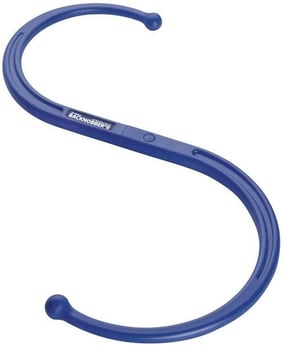These days, patients both expect and desire to be proactive in their care. "What can I do at home for myself?" is a common question in clinics of all disciplines, particularly in the economic environment. Fluid movement—undulation—allows for a high level of patient participation without requiring additional specialized spaces or equipment—and leads to improved compliance and overall clinical outcomes. Kimberly Kohr, DC, a chiropractor and exercise instructor, and Anita Boser, LMP, CHP, author of Relieve Stiffness and Feel Young Again With Undulation, explain how.
This article was written by Kimberley Kohr, DC and Anita Boser, LMP, CHP for dynamicchiropractic.com. Ther original article can be found here.
Undulation is the flowing movement through multiple joints. Our bodies naturally undulate whenever we move unless tension or restriction prevents it. Can intentional undulation movements facilitate the chiropractic adjustment? Can they improve patient outcomes in both the short and long term? The answer to both is an emphatic yes.

Chiropractors know that not every joint moves smoothly, or even at all in some cases. It is generally far easier to adjust the spine of someone who has either just exercised or received a massage—hence the use of massage therapists, intersegmental traction, wobble chairs, exercise balls and other movement devices in our practices. Moreover, techniques such as motion palpation and flexion distraction are based upon undulation of the joint.
James Chestnut, DC, chiropractic wellness teacher and coach, believes "movement is life." It is well-accepted within the profession that movement throughout each component of the spinal motion unit is critical for healthy joint and disc function. Movement increases joint hydration, aids in supplying oxygen and nutrients to the joint, increases strength and flexibility, and helps maintain the CSF pump.
A direct correlation has also been demonstrated between the amount of proprioceptive/kinesthetic sensory stimulus to the brain and learning ability, active recall, emotional status, and behavioral patterns (Restak RM, The Brain, the Last Frontier, 1979). We can teach our patients techniques that will help them know when their bodies are subluxated and aid them in their pursuit of better health. Purposeful undulation can result in decreased doctor-patient time (patients are easier to adjust) and increased patient compliance.
Undulation movements are an excellent methodology for introducing and reinforcing an active proprioceptive and kinesthetic firing pattern. Simple movements with specific motion goals are taught to the patient for both clinical and home applications. Undulation movements are used to "teach" the patient which spinal motion units are working effectively, how to isolate the units that are not, and with time, how to develop and maintain an optimum movement profile.
Proprioception and kinesthetic awareness are often diminished by long-standing movement patterns and impinged spinal nerves. An exercise that increases awareness will start a cascade of positive change. It also will help many patients realize that the segments of greatest restriction are not necessarily the places with the most pain, and highlight the need to stretch and strengthen the entire spine, not just the places that hurt.
 Many of these exercises are essentially a motion palpation technique performed by the patients on themselves, such as "feel your spine." With your patient sitting on a chair, help them feel their sacrum with their fingers, then rock the hips so the sacrum makes small movements they can feel. Then direct the patient to move their finger up about an inch to find the "bony bump" of a spinous process and wiggle their low back to move this forward to back, side to side, and in small rotations.
Many of these exercises are essentially a motion palpation technique performed by the patients on themselves, such as "feel your spine." With your patient sitting on a chair, help them feel their sacrum with their fingers, then rock the hips so the sacrum makes small movements they can feel. Then direct the patient to move their finger up about an inch to find the "bony bump" of a spinous process and wiggle their low back to move this forward to back, side to side, and in small rotations.
After noticing the available movement in that segment, repeat the process up the spine as far as can be reached comfortably. For patients who are more concerned with their neck, start the process at the occiput and work down the "bumps" of the cervical spine.
"Easy sway" is a lateral flexion undulation. From a seated position, direct your patient to lean to the left so the right side of their body stretches, and to the right so the left side of their body stretches. The movements should be easy and minimal. As the patient continues to sway, ask them to notice which parts of their spine move easily, if there are any parts that may move too much, and which parts are stiff. Guide them to stop and start again, but this time initiate the movement from one of the stiff places. After 20 seconds of movement, the stiffness will soften somewhat and movement will become easier. Repeat the process with a few other stiff segments; you may even suggest one based on your observations. Most patients are amazed by the quality of movement they can create with less than two minutes of gentle movement.
The "tailbone penmanship" undulation focuses on lumbar and sacral segments; it can be done on the hands and knees or seated on a chair—or better yet, on an exercise ball. With the patient in a seated position, have them imagine their tailbone is a laser pointer that sends a beam of red light to the floor. Direct the patient to draw a cursive letter "A" with the laser pointer, taking their time to smooth out the curves, initiate the movement from the pelvis, and let the movement from the pelvis flow up through their spine. You can direct patients to write the alphabet, their name, or even a saying (e.g., "I feel great because of chiropractic care!"). The alphabet will be too much for patients who are acute or weak, but consistent practice and the gradual addition of a letter or two will build mobility and strengthen the core muscles of the pelvis and lumbar spine.
It takes only a few minutes for region-specific undulations to be performed and is easily managed prior to adjustment. Handouts can be provided with instructions and diagrams. Also, depending upon your state scope of practice, teaching undulation movements can be potentially billed under exercise instruction, supervised activity, ADL, and the like.
These exercises can easily be performed at home or work. Once a patient understands the basic concepts of the movements, it is easy for them to find time in their busy lives to undulate their spines. For instance, undulations can be coupled with basic activities such as brushing your teeth or waiting for a Web page to load. Contraindications include spinal canal stenosis, acute or grade II+ spondylolisthesis, and moderate or greater disc bulges. And of course, as with all activity protocols, pain means stop.
Dr. Kimberly Kohr, a 1992 graduate of Palmer College of Chiropractic, practices in Washington state, where she complements her chiropractic practice with yoga and ball exercise classes, and is a tai chi instructor.
Anita Boser, a graduate of the Institute of Structural Medicine, maintains a Hellerwork practice in Washington. She is the author of Relieve Stiffness and Feel Young Again With Undulation.
This article was written by Kimberley Kohr, DC and Anita Boser, LMP, CHP for dynamicchiropractic.com. Ther original article can be found here.


